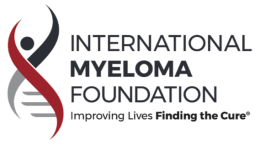Generally, the definition of relapse in multiple myeloma is the reappearance of signs and symptoms of a disease after a period of improvement. Patients with relapsed multiple myeloma are those who have been treated. Yet, these patients develop signs of the disease that have been defined by the International Myeloma Working Group (IMWG). The IMWG response criteria are used to determine patients' responses during treatment in clinical trials and are very precise.
The International Myeloma Working Group consensus criteria for response and minimal residual disease assessment, published in The Lancet Oncology in August 2016, states that clinical relapse requires one or more of the following criteria. These criteria are direct indicators of increasing disease and/or end-organ dysfunction (CRAB features):
- Definite increase in the size of existing plasmacytomas (tumor composed of plasma cells) or bone lesions.
- Hypercalcemia, which is above normal calcium levels in the blood (> 11 mg/dL).
- Decrease in hemoglobin (protein in red blood cells that carries oxygen) of ≥ 2 g/dL not related to therapy or other non-myeloma-related conditions.
- Rise in serum creatinine (muscle waste product in the blood) by 2 mg/dL or more from the start of the therapy and attributable to myeloma.
- Hyperviscosity (thickening of the blood) related to serum protein.
- Increase of 25% from the lowest confirmed response value in one or more of the following criteria:
- Serum M-protein (the increase must be at least 0.5 g/dL).
- Urine M-protein (the increase must be at least 200 mg/24 hours).
- If no serum or urine M-protein can be measured, the difference between the involved (abnormal, or monoclonal) and uninvolved (normal or polyclonal) free light chain levels (the increase must be >10 mg/dL).
The following may be signs that multiple myeloma is relapsing based not upon CRAB criteria, but upon biological markers.
No patient should be treated solely "by the numbers." Your disease history and your doctor's experience and judgment must guide the decision to change or re-start treatment. Multiple myeloma is different in every patient. Each patient must be evaluated as an individual, not as a statistic.
How Is Relapse Detected?
Sometimes relapse is symptomatic — a pain in a boney area caused by new or ongoing bone disease, for example. Sometimes, relapse can only be picked up by a blood test or an imaging study. Blood test and imaging monitor response in a patient receiving therapy or disease status in a patient who is off therapy. The tests used to monitor a patient for relapse are those used to establish a baseline at diagnosis. Repeating the baseline tests provides a means of comparison.
The table below lists the full scope of tests used to monitor therapy responses and possible relapse. Not every test on the table is appropriate for every patient. Your baseline testing, disease history, and treatment history will guide your doctor to choose tests appropriate for you.
Tests to Monitor Relapse and Response
| Blood Tests |
|
| Urine |
|
| Bone Evaluation |
|
| Bone Marrow |
|
IMF thanks Pfizer for supporting this glossary
What's Next?
Learn what to do if you relapse early in your course of treatment.
Myeloma patients may experience periods of response, followed by relapse.
The International Myeloma Foundation medical and editorial content team
Comprised of leading medical researchers, hematologists, oncologists, oncology-certified nurses, medical editors, and medical journalists, our team has extensive knowledge of the multiple myeloma treatment and care landscape. Additionally, Dr. Brian G.M. Durie reviews and approves all medical content on this website.
Last Medical Content Review: July 30, 2021





